Archived Article Detail
By Thomas P. Moore
WHAT’S NEW IN THE MINERAL WORLD ARCHIVE – posted on 5/13/2005
Welcome to the second installment of “What’s new in the mineral world.” Earlier installments will be archived here for future reference, as each new one is posted. My thanks to everyone who has contributed news thus far; more is always welcome. In that connection, please note my new e-mail address:
Strands From The Web
There is surely no country “hotter” today for specimen minerals than China, and for this we can thank, first, the busy Chinese mineral merchants themselves, and equally those Westerners who are going to China in ever-increasing numbers for treasure hunts. One of the Westerners in question is Dan Weinrich of St. Louis, who returned from China in March with mineralogical miscellanies and observations; I will paraphrase some of the latter here.
Almost every Chinese dealer in Changsha, Daye and Guilin (mineral-marketing centers, all) seems to have fine specimens of the new epidote and quartz from Sichuan, mentioned last time—Dan Weinrich saw several thousand specimens of the material in-country, and, as there seem to be different subtypes of the specimens, it may be that different collecting sites are involved. In some specimens the quartz is colorless while in others it is deeply amethystine; the quartz in some of the specimens shows bright red included hematite, in others not; in some specimens, white dolomite is included, in others not; and so on. You will be shocked—shocked!—to learn that practically all specimens show some degree of damage.
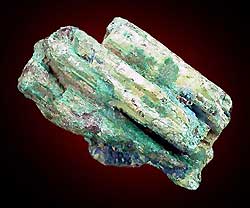 Dan also saw some superb blue hemimorphite from Malipo, Hunan province; rhodochrosite specimens suggesting Silverton, Colorado pieces, as well as specimens showing apatite and tetrahedrite crystals, “from the Babu area”; very bountiful supplies of transparent green fluorite specimens from the Xianghuapu mine (see Ottens, “Chinese fluorite,” in Jan.-Feb. 2005); a doubly terminated, 2.5-cm crystal of malachite-coated bournonite from Xuebaoding Mountain, Sichuan (X-ray verified as bournonite, and a new species for the locality); and great numbers of specimens of the “Bisbee-like” azurite from Guichi, Anhui province which I mentioned in my 2005 Tucson Show report. The Bisbee-likes which Dan saw last December in Daye show drusy azurite over large matrix plates and, rarely, open vugs in malachite-azurite masses lined with sharp, lustrous azurite crystals to more than 1 cm. From the same area there are massive pieces of cuprite decked out with sharp cuprite crystals to 1 cm. Dan doesn’t necessarily have all of these items for sale at any one moment, but to get a good picture (literally: the photos on his site are usually quite fine) of what he does have, you may go to www.danweinrich.com.
Dan also saw some superb blue hemimorphite from Malipo, Hunan province; rhodochrosite specimens suggesting Silverton, Colorado pieces, as well as specimens showing apatite and tetrahedrite crystals, “from the Babu area”; very bountiful supplies of transparent green fluorite specimens from the Xianghuapu mine (see Ottens, “Chinese fluorite,” in Jan.-Feb. 2005); a doubly terminated, 2.5-cm crystal of malachite-coated bournonite from Xuebaoding Mountain, Sichuan (X-ray verified as bournonite, and a new species for the locality); and great numbers of specimens of the “Bisbee-like” azurite from Guichi, Anhui province which I mentioned in my 2005 Tucson Show report. The Bisbee-likes which Dan saw last December in Daye show drusy azurite over large matrix plates and, rarely, open vugs in malachite-azurite masses lined with sharp, lustrous azurite crystals to more than 1 cm. From the same area there are massive pieces of cuprite decked out with sharp cuprite crystals to 1 cm. Dan doesn’t necessarily have all of these items for sale at any one moment, but to get a good picture (literally: the photos on his site are usually quite fine) of what he does have, you may go to www.danweinrich.com.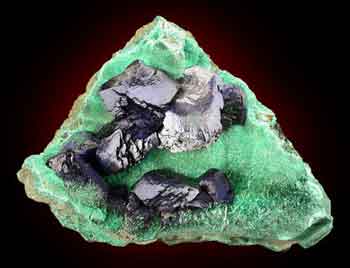
Rob Lavinsky of The Arkenstone, who keeps up with many things, has been doing his best to keep up with China as well. Lately he has been advertising a small number of loose, gemmy lilac crystals of scapolite from a place called Daftar, Xinjiang province…and, yes, the crystals look just like the ones from Badakhshan, Afghanistan which have been coming onto the market during these past two years or so. Rob is very careful about locality information, i.e. probably as trustworthy as any Westerner can be in this regard, and he swears that these crystals come from China, although I’ve seen a lot of the Afghan ones and you coulda fooled me (more and more “Chinese” specimens actually originate in other countries these days). The purported Chinese crystals are lustrous, vertically striated, almost totally gemmy, elongated prisms to about 3 cm, lavender with a hint of pink; nearly all are singly, and one is doubly, terminated. No associated species are evident. That web address again is www.irocks.com.
Also showing up on the Arkenstone site—and nowhere else yet that I have seen—is some material newly found at an unspecified site(s) in the Rift Valley Province of Kenya. First, there are sceptered smoky and amethystine quartz crystals, many with heavy inclusions of hematite or lepidocrocite, some with movable water bubbles—the reminiscence, of course, is of the famous quartz crystals from “Brandberg,” Namibia. Then, from a contact-metamorphic deposit (although I’m guessing, of course) are some specimens showing gemmy, honey-brown grossular crystals to 1.5 cm embedded in massive blue calcite; bright yellow, transparent, rounded and droplet-like crystals of vesuvianite in the same blue calcite; miniature-size, icy-looking groups of subhedral crystals of the blue calcite itself; and lustrous deep blue spinel octahedrons to 1 cm in “dirty” white marble. A couple of years ago, world-class epidote specimens out of Kenya surprised Tucson showgoers; this new material, which comes with even less provenance information than the epidote did, is clearly a new and different occurrence. Rob Lavinsky says don’t worry, he’s on the investigative case, and will probably get more of these interesting Kenyan items.
An Italian dealership called Web Mineral Shop (www.webmineralshop.com) has come up with a suite of evaporite minerals, the exact likes of which I’ve never seen before, from the Sahara Desert of Egypt. Specifically the locality is Wâdi el Natrûn, or the Natrun Depression, a 50-kilometer-long ovaloid of a dry lake bed which my atlas locates about 80 km northwest of Cairo and 100 km south of the history-haunted coastal city of Alexandria. The clusters of halite crystals from this locality, which reach to small-cabinet sizes, look very much like halite specimens from some of the California evaporite deposits, with sharp, transparent, deeply hoppered cubic crystals tinted pale pink to red by organic inclusions. Trona occurs in the Wâdi as lustrous, cream-colored to pale orange, translucent crystals in spherical aggregates to 3 cm, these mixed intimately with the groups of hoppered halite crystals or associated, in other specimens, with crystals of thenardite and of the very rare sulfate-carbonate species burkeite. And specimens which consist mainly of thenardite are pretty, too: sparkling orange-pink crystal bundles with halite, trona and burkeite.
Speaking of vaguely scary mineral sites in stark deserts, David K. Joyce (www.davidkjoyceminerals.com) has a geologist friend who, while on a geological reconnaissance trip in Yemen, gathered a small number of fine epidote specimens at a remote place of unspecified geological nature about 320 km east of Aden. David was offering just three of these specimens on his site, while expressing some optimism about latching on to more. Lustrous, bladed, dark green epidote crystals to more than 5 cm, singly or as subparallel clusters, came out of the wasteland without matrix or any associated species; the crystal terminations are typically chisel-shaped, with stepped growth features.
Good selections of specimens of rare and interesting species (“interesting” = you think you sort of know what they are, but would not bet your best bournonite on the accuracy of your knowledge) are to be seen on the site of a fairly new dealership called Minwreck (www.minwreck.com). Brandy and Justin of Minwreck have just moved to Tucson from California, and they bring to the web a certain distinct persona (“…between the species collector and you whacked-out hippies, somebody NEEDS some mizzonite…”) which makes their site, as intended, fun to visit; but, make no mistake, the stock is highly sophisticated. From a recent safari in Africa the dealership brought back numerous small specimens of villiaumite and tuperssuatsiaite from the Aris phonolite quarry south of Windhoek, Namibia. The tuperssuatsiaite occurs as delicate upstanding tufts, to a few millimeters, of gray-green acicular crystals; thumbnail-size specimens show between 1 and 5 such little tufts, plus needle quartz crystals, scattered over a salt-and-pepper igneous matrix. The villiaumite specimens show clumps of subhedral crystals in laid-open cavities in miniature-size pieces of the same igneous matrix—but the villiaumite here is not maroon, as at Mont Ste.-Hilaire and on Russia’s Kola Peninsula, but is bright orange, lustrous and transparent, cf. the superlative crystal which Rob Lavinsky brought to Munich in 2004, and which I mentioned in my report from there.
Other species offered, in mostly thumbnail and miniature specimens of “reasonable” to very fine quality, on the Minwreck site include euxenite from Madagascar; Chinese kermesite (the big market surge of this is now definitely over); nigerite from Uis, Namibia; loose prisms of what is unfortunately being called “mizzonite” (somewhere between marialite and meionite in the scapolite series) from Nepal; and loose, sharp, 2-cm octahedrons of sulfohalite from Trona Salt Lake, California. Right on.
In 1965, getchellite, AsSbS3, was described as a new species from the Getchell gold mine, Humboldt County, Nevada, a locality famous for the fine crystal specimens of realgar which peaked in availability during the 1950’s and 1960’s. Little has been heard from the Getchell mine since its closure in 1968, but now Scott Kleine of Great Basin Minerals (www.greatbasinminerals.com) is offering some pieces of mixed arsenic sulfides collected in the south pit of the mine in 1988-1989, whereon some crude, cherry-red getchellite crystals and crystal sections to a few mm show up among cleavage planes of getchellite, orpiment, pararealgar and stibnite.
Followers of the show scene may recall that in 1999-2000 the market suddenly became enriched in large clusters of stibnite crystals, many decorated on the prism faces with “sugar-cube” barite crystals, from the Murray mine, Elko County, Nevada. Well, Scott Kleine’s website features appetizing offerings of highly lustrous, crudely terminated black stibnite prisms to 10 cm long, with patches of adhering drusy quartz, from the Murray mine. Most of the specimens are single crystals or thin groups of sub-parallel crystals, but there is one fine V-growth of two thin prisms, the longer measuring 4 cm. A few years ago now, Murray mine stibnite abruptly ceased to be “around,” and this was a pity, since it may well be the best U.S. stibnite of the 20th century (specimens from the Stayton district, California date from the late 19th century).
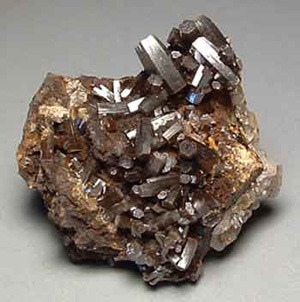 Already, in my print reports on the Denver shows of 2003 and 2004, I have saluted Chris Tucker for his having first field-collected, then marketed in generous quantity, the remarkable vanadinite specimens of the North Home mine, Broadwater County, Montana. You look at these specimens and think immediately of the famous brown vanadinite (so-called “endlichite”) specimens once found at Los Lamentos, Chihuahua, Mexico (see the Nov.-Dec. 2003, “Mexico III” issue). Silkily lustrous, elongated, subtly color-zoned pale brown to red-brown vanadinite crystals grow all over matrix plates or as loose, delicate clusters; most of the Montana crystals are slightly curved such that the loose groups have a sort of feather-plume aspect, and this is the biggest visible difference between them and the Los Lamentos specimens. Chris Tucker has now bought the North Home mine, and continues to work it vigorously, and to name individual pockets whimsically, and to market large numbers of very impressive vanadinite specimens in a wide range of sizes: see www.christuckerminerals.com.
Already, in my print reports on the Denver shows of 2003 and 2004, I have saluted Chris Tucker for his having first field-collected, then marketed in generous quantity, the remarkable vanadinite specimens of the North Home mine, Broadwater County, Montana. You look at these specimens and think immediately of the famous brown vanadinite (so-called “endlichite”) specimens once found at Los Lamentos, Chihuahua, Mexico (see the Nov.-Dec. 2003, “Mexico III” issue). Silkily lustrous, elongated, subtly color-zoned pale brown to red-brown vanadinite crystals grow all over matrix plates or as loose, delicate clusters; most of the Montana crystals are slightly curved such that the loose groups have a sort of feather-plume aspect, and this is the biggest visible difference between them and the Los Lamentos specimens. Chris Tucker has now bought the North Home mine, and continues to work it vigorously, and to name individual pockets whimsically, and to market large numbers of very impressive vanadinite specimens in a wide range of sizes: see www.christuckerminerals.com. 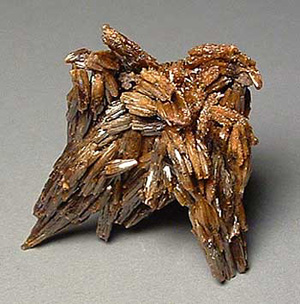
One German website surprised me with a good showing of specimens from a classic occurrence much cherished in Europe, and not exactly a target of scoffing elsewhere, either. Among its more predictable offerings of minerals mostly from contemporary occurrences, the dealership of Mineralium (www.Mineralium.com) has about 10 good specimens of fluorite from the famous Grube Clara (Clara mine) near Oberwolfach in the Black Forest, Baden-Württemberg, Germany. The Grube Clara is the last still-active mine in the Black Forest region, exploiting fluorite and barite veins. At times in its century-long past it has also produced ores of copper, lead and silver, and collectors today, for a small fee, may enter the mine and look for microcrystals of some of the 250 or so mineral species known from the deposit. The fluorite specimens offered by Mineralium all display sharp, perfectly colorless and transparent, cubic crystals averaging 1 cm or so on edge, as loose groups and solidly lining cavities. The specimens, not recently collected, range in size from 4.5 x 6 cm to 7 x 14 cm, and look impressive enough, even though the fluorite lacks the beautiful pale blue hue seen in some old Grube Clara pieces.
Now that I’ve rambled my way to Europe, I’ll make the last “strand from the web” a recommendation that those interested in good locality articles might do well to visit the website of Marco Macchieraldo of Torino, Italy: web.tiscali.it/mmacchieraldo (the address looks peculiar, but if your computer balks you can also access the site through that useful meta-site called The Vug, www.the-vug.com). Marco has had his site since July 1999, and although he does use it to sell minerals (primarily from the Italian Alps) he also shows off his personal collection and shares two excellent articles he has written on two famous Italian Alpine localities: Val Varaita, Piedmont and Monte Bianco, i.e. the Italian side of Mont Blanc. The articles are furnished with maps, photographs, crystal drawings and other graphics, geological and mineralogical erudition, collecting stories and tips, and an animated Italianate-English prose style; and there is nothing wrong, either, with the specimens shown, especially those from “Monte Bianco.” As the mineralized clefts on the Italian side of Mont Blanc have generally gotten much less attention than those on the French side, it’s pleasant to see an article devoted to them alone.
Locality News
Intriguing and tantalizing developments are now under way at two classic Australian mineral localities: the Adelaide mine, Dundas, Tasmania and the Mount Isa mine, Mount Isa, northern Queensland. I’ll summarize the scoops here, and further information on both may be found at www.theadelaidemine.com, the website (still under development) of The Adelaide Mining Company Pty Ltd., or TAMC for short. Adam Wright of TAMC is the helpful man with whom I’ve been communicating; if you want to do so too, e-mail alwright@theadelaidemine.com.
For more than 30 years now, the Adelaide mine has been leased or owned by Frank Mihajlowits, the “Mr. Crocoite” whose dedicated collecting efforts have brought the world most of the very best of its crocoite specimens—see part of his story (and a picture of him) in Bancroft’s Gem & Crystal Treasures (1984). But in July 2004, TAMC purchased the lease on the Adelaide mine from Mihajlowits, and a new specimen-mining program is now under way, beginning in the area of a large crocoite pocket which Mihajlowits hit in 1991. The TAMC miners also intend to search for specimens of other minerals known to occur in the mine, including dundasite, cerussite (yellow and white), phosgenite and chlorargyrite. The TAMC website opened in December 2004, and will be used, of course, to market whatever specimens are found, but the company is also seeking to trade, purchase or sell on consignment other Tasmanian mineral specimens, and to establish a presence on the international mineral show circuit. The crocoite specimens now being offered are typical jumbled red-orange crystal groups, some of the crystals visibly hollow, a few showing terminal faces; the specimens are lustrous and look quite clean, and their prices are well within the civilized pale. Individual clusters range from about 4 cm to 17 cm across, and wholesale flats are also available.
The TAMC company is also monitoring some operations at the Mount Isa mine in Queensland: for background see Robert Sielecki’s article “The Mount Isa-Cloncurry Mineral Field” in the Australia! Issue, Nov.-Dec. 1988. According to Adam Wright, the mine’s Black Star Open Cut, where oxidized lead, zinc and silver ores, and some fine mineral specimens, were found in the 1930’s (Sielecki, 1988), is being redeveloped, a northern extension of the cut penetrating a gossan zone on an upper bench. 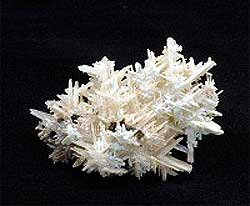 Here, between December 2004 and March 2005, a miner found about 30 fine specimens of cerussite ranging from 2.75 to 5 cm, plus about 60 thumbnail-size specimens; the cerussite clusters are loose, lustrous “snowflakes” of reticulated crystals, pure white and translucent to colorless and transparent. In average quality these specimens far exceed the 1-cm cerussite crystals and reticulated twins found in the Black Star Cut in the late 1960’s. Also, the gossan has yielded a few good pyromorphite specimens, none larger than thumbnail size.
Here, between December 2004 and March 2005, a miner found about 30 fine specimens of cerussite ranging from 2.75 to 5 cm, plus about 60 thumbnail-size specimens; the cerussite clusters are loose, lustrous “snowflakes” of reticulated crystals, pure white and translucent to colorless and transparent. In average quality these specimens far exceed the 1-cm cerussite crystals and reticulated twins found in the Black Star Cut in the late 1960’s. Also, the gossan has yielded a few good pyromorphite specimens, none larger than thumbnail size.
Private Collection News
Every serious mineral collector today knows (or at least knows of) Marty Zinn, originally of Texas, now of Colorado, the indefatigable show promoter whom we have to thank for making the annual hotel shows at Tucson and Denver, as well as the big shows at Springfield and Costa Mesa, come off so smoothly each year. Marty also has been one of the most dedicated top-flight collectors of recent times, and he wowed ‘em with an exhibit of most of his fantastic collection at Springfield in 1999; to see pictures of a few of his finest specimens, and to read an account of his career as a collector, see Wendell Wilson’s “Collector Profile” article in July-August 1999.
I was surprised to learn recently that Marty has decided to sell off nearly his whole collection. There’s always something a little sad about the dispersal of a collection which was someone’s longtime labor of love, but of course it is big news, too, for other private collectors who now have a chance to acquire wonders previously off-limits to them. Marty is retaining his sub-collection of thumbnails, as well as some Sweet Home mine rhodochrosites (he was among the original major investors in the Sweet Home mining project) and some pieces which had belonged to his late mother Betty Llewellyn, also in her time a dedicated collector. But that still leaves about 4500 specimens, mostly of highest quality and predominantly “aesthetic,” which are now due to hit the market. They will be sold off in waves over the next few months or years by three dealerships: Collector’s Edge Minerals of Golden, Colorado (Bryan Lees), Kristalle (Wayne and Dona Leicht), and Crystal Classics (Ian Bruce). So watch for lots of lots from the Zinn Collection—this will make a fine pedigree for the specimens—appearing with these three dealers, beginning, I’m told, at the Costa Mesa show in mid-May 2005.
Another, really sad, recent development in the collecting world was the sudden death in October 2004 of Jesse (“Jay”) Lininger, prime mover of Matrix, the fine periodical publication concerned chiefly with historical mineralogy. Jay had kept at his home in Dillsburg (near Harrisburg), Pennsylvania his private collection consisting solely of mineral specimens from Pennsylvania localities: certainly one of the most comprehensive collections of Pennsylvania minerals ever assembled by a private collector. As I write this (in early May 2005) the collection has just been sold at auction, the proceeds to be entirely donated to the Liningers’ church in Mechanicsburg. Steve Carter (SCarter@pennminerals.com) informs me that the auction was attended by many top collectors and dealers, was lively, and in general was a terrific success, bringing in close to $200,000. The biggest successful bid, $8,500, bought a specimen of fluorapatite from the old Cornog, Chester County, Pa. locality, inactive since the late 1960’s but known in its time for brilliant, colorless-transparent fluorapatite crystals fully the equal of the best from the Swiss and Austrian Alps.
Paula Lininger kindly sent me a copy of the auction catalog, and, as a native Pennsylvanian who more or less cut my mineralogical teeth on the localities of the state’s southeastern corner, I had a fine time racing my imagination down the road of this (pictureless) text, with nostalgia my rearview mirror. To be sure, many auction lots consisted of massive and “study” specimens, and there were many brief descriptions in which terms like “blebs…nodules…dendrites…coatings on rock” were central, and one had only the resonant names of long-gone classic localities to dream on. However, in other items, words and phrases tantalized by gesturing towards, while ultimately occluding, such faraway shining realities as…well…brucite crystals forming rosettes on matrix, from Wood’s mine; large pyromorphite crystals covering matrix, Wheatley mine, Phoenixville; a textbook crystal of anglesite in a 2-inch vug in galena, Wheatley mine, Phoenixville, with Harvard label; yellow-green gemmy twinned titanite crystals, Bridgewater Station; 2-inch cyclic-twinned rutile, Parksburg; doubly terminated 5-inch amethyst crystal, Upper Providence, with an American Museum label; 4-inch terminated crystals of clinozoisite, Cornog; large plate of acicular millerite, Gap mine; 1.5-inch pyrite octahedron, French Creek. Congratulations to Steve Carter, Joe Dague, Paula and other members of the Lininger family, and all others who made this auction the memorable success that it clearly was.
Museum News
First of all, the rumors are not true: the Carnegie Gem and Mineral Show in Pittsburgh will take place as usual this year, and planning for it is already well under way. There had been some vague talk that the Carnegie Museum had decided to stop sponsoring this event, which has come to be known as perhaps the world’s classiest mineral show, marked by receptions and ceremonies for tuxedo-clad guests, appearances by winners of the annual Carnegie Award, tours of the superlative collection on display in the Hillman Hall of Minerals and Gems, and, yes, a few dealers on hand to show their wares. But, repeat, the rumors of the show’s demise are not true; the event will take place on November 18, 19 and 20. For this 25th anniversary year of the opening of Hillman Hall, the proceedings will be as lavish as ever, and Silver, natch, will be the theme.
Since moving to Tucson four years ago I have gone innumerable times to the downtown campus of the University of Arizona, there to take innumerable pleasant tours of the small-but-spiffy display facility of the school’s Mineral Museum in the basement of the Flandrau Planetarium building. Of course the mineral collection does not compete seriously with those you will see in the great natural history museums of Washington, New York, Houston, London, Paris, etc., but it has two great strengths: Arizona minerals (with terrific things from Bisbee, Morenci, Tiger and other nearby hallowed places) and Mexican minerals (with top pieces from the collection of the late Miguel Romero, these including the great “Aztec Sun” legrandite from the Ojuela mine, and what are probably the finest extant Mexican acanthite, pyrargyrite and creedite specimens). There is, further, a very respectable systematic collection, and there are well-presented cases on themes including copper minerals, lead minerals, calcite, quartz, pyrite, pseudomorphs, gem crystals, and more.
On my last visit to the Museum, Shirley Wetmore, the friendly curator, pointed me to a recently installed case displaying part of the mineral collection of Bryan L. Sage, a U of A alumnus who died last year, leaving the collection to the Museum. Sage, born in Houston in 1953, had picked up “pretty rocks” since childhood and later had specialized in micromounts, either as cause or effect of a strong interest in optics and in photography. A computer programmer by trade, he had traveled the world to photograph solar eclipses, and had planned eventually to photograph his entire collection of micromount specimens. The “general” collection he left to the University of Arizona consists of about 1,000 micromounts, 300 miniatures, 40 thumbnails, two microscopes, two beautiful collection cases, many books, and a nearly complete set of the Mineralogical Record. The miniature collection is especially strong on specimens from the western U.S., and it will remain on display in its special flat case in the Museum for a full year…and right beside it, by the way, is a case displaying some exceptional specimens from the collection of the late Richard Bideaux. Furthermore, the Mineral Museum has lately re-arranged the best of the Mexican specimens from the Romero collection, putting them all together in four effective, wide cases along one wall—and wonderful western mining-related paintings by William Davidson White (1896-1971) hang everywhere in the hall.
Have a cool summer, everyone; a good start would be to resolve to stay out of Tucson, unless, of course, you bring your asbestos suits, or unless you intend to visit the U of A’s Mineral Museum (where personnel will hold your asbestos suits for you by the door).
For questions about this column, please email Tom Moore.
